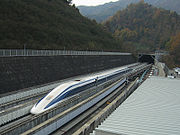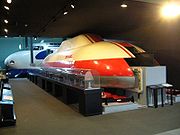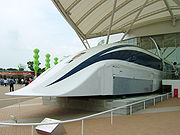
JR-Maglev
Encyclopedia

JR-Maglev is a magnetic levitation train system developed by the Central Japan Railway Company
Central Japan Railway Company
The is the main railway company operating in the Chūbu region of central Japan. It is officially abbreviated in English as JR Central and in Japanese as . Its headquarters are located in the JR Central Towers in Nakamura-ku, Nagoya, Aichi Prefecture.The company's operational hub is Nagoya Station...
and Railway Technical Research Institute
Railway Technical Research Institute
, or , is the technical research company under the Japan Railways group of companies.- Overview :RTRI was established in its current form in 1986 just before Japanese National Railways was privatised and split into separate JR group companies. RTRI conducts research about everything related to...
(association of Japan Railways Group). JR-Maglev MLX01 (X means experimental) is one of the latest designs of a series of Maglev train
Maglev train
Maglev , is a system of transportation that uses magnetic levitation to suspend, guide and propel vehicles from magnets rather than using mechanical methods, such as friction-reliant wheels, axles and bearings...
s in development in Japan since the 1970s. It is composed of a maximum five cars to run on the Yamanashi
Yamanashi Prefecture
is a prefecture of Japan located in the Chūbu region of the island of Honshū. The capital is the city of Kōfu.-Pre-history to the 14th century:People have been living in the Yamanashi area for about 30,000 years...
Maglev Test Line. On 2 December 2003, a three-car train reached a maximum speed of 581 km/h (361 mph) (world speed record for railed vehicles
Land speed record for railed vehicles
Determination of the fastest rail vehicle in the world varies depending on the definition of "rail".Official absolute world record for conventional train is held by the French TGV...
) in a manned vehicle run.
The JR-Maglev system uses an Electro-dynamic Suspension (EDS)
Electrodynamic suspension
Electrodynamic suspension is a form of magnetic levitation in which there are conductors which are exposed to time-varying magnetic fields. This induces currents in the conductors that creates a repulsive magnetic field which holds the two objects apart....
system. The maglev-trains have superconducting
Superconductivity
Superconductivity is a phenomenon of exactly zero electrical resistance occurring in certain materials below a characteristic temperature. It was discovered by Heike Kamerlingh Onnes on April 8, 1911 in Leiden. Like ferromagnetism and atomic spectral lines, superconductivity is a quantum...
magnetic coils, and the guide ways contain levitation coils. As the train moves, its moving magnetic field
Magnetic field
A magnetic field is a mathematical description of the magnetic influence of electric currents and magnetic materials. The magnetic field at any given point is specified by both a direction and a magnitude ; as such it is a vector field.Technically, a magnetic field is a pseudo vector;...
s create a current in the levitation coils because of the magnetic field induction effect
Electromagnetic induction
Electromagnetic induction is the production of an electric current across a conductor moving through a magnetic field. It underlies the operation of generators, transformers, induction motors, electric motors, synchronous motors, and solenoids....
. These currents create a magnetic field that interacts with the magnetic field of the superconductive coils to create a force that holds up and stabilises the train.
Technology
| |
|
 Levitation System |
 Guide System |
| |
|
 Drive System |
|
- See also: technology in the magnetic levitation train article.
The trains use a levitation system, a guide system, and a driving system.
The different prototypes have worked in slightly different ways, but the current track has a series of figure-of-8 wound coils along both sides that are also cross-connected with wires that go underneath the track.
When the trains run at high speed, if the magnetic field of the approach of the superconducting magnetic coils is centered then the electrical potential is balanced and no currents are induced.
However, typically, the train is running slightly below the centre of the coils due to gravity. Then the electrical potential is no longer balanced, and this causes a current that creates a reactive magnetic field that opposes the superconducting magnet's pole (in accordance with Lenz's law) and a pole above that attracts it, and so the train is pushed and pulled upwards, and prevented from falling.
Levitation coils on the guide way generate guiding and stabilizing forces also.
If the train moves to the left, then currents are induced due to the cross-connections between the track coils that push and pull it straight.
EDS allows larger gaps than EMS
Electromagnetic suspension
Electromagnetic Suspension is the magnetic levitation of an object achieved by constantly altering the strength of a magnetic field produced by electromagnets using a feedback loop...
, but requires support wheels for relatively low speeds, when it can't produce a large levitation force. The wheels retract once the train reaches 150 km/h (93.2 mph). JR-Maglev floats 10 centimetres (3.94 in) above the guideway.
JR-Maglev is driven by a Linear Synchronous Motor (LSM)
Linear motor
A linear motor is an electric motor that has had its stator and rotor "unrolled" so that instead of producing a torque it produces a linear force along its length...
System, which powers the coils at the guide way.
Miyazaki Test Track
After maglev tests moved to Yamanashi Prefecture, the Railway Technical Research Institute (RTRI) began in 1999 to allow the test of ground effect trainGround effect train
A ground effect train is an alternative to a magnetic levitation train. In both cases the object is to prevent the vehicle from making contact with the ground...
s based on wing-in-ground-effect (WIG) at the former site in Hyūga City
Hyuga, Miyazaki
is a city located in Miyazaki, Japan.The city was founded on April 1, 1951.On February 25, 2006 the town of Tōgō, from Higashiusuki District, was merged into Hyūga....
, Miyazaki Prefecture
Miyazaki Prefecture
is a prefecture of Japan located on the island of Kyushu. The capital is the city of Miyazaki.- History :Historically, after the Meiji Restoration, Hyūga Province was renamed Miyazaki Prefecture....
.
Yamanashi Test Track
Yamanashi Experiment Lines are facilities that currently have a practical use. It includes about 18.4 km (11.4 mi) of track (including 16 km (9.9 mi) of tunnels). The test track is currently being extended from 18.4 kilometre with completion expected for 2013/14. This is part of the planned Chūō ShinkansenChuo Shinkansen
The is a planned maglev line connecting Tokyo, Nagoya, and Osaka, Japan. The only part of the line that exists is the Yamanashi test track, which is currently being extended from 18.4 km to 42.8 km. The line is proposed to connect Tokyo and Nagoya in the first stage in 40 minutes, and eventually...
connecting Tokyo
Tokyo
, ; officially , is one of the 47 prefectures of Japan. Tokyo is the capital of Japan, the center of the Greater Tokyo Area, and the largest metropolitan area of Japan. It is the seat of the Japanese government and the Imperial Palace, and the home of the Japanese Imperial Family...
, Nagoya, and Osaka
Osaka
is a city in the Kansai region of Japan's main island of Honshu, a designated city under the Local Autonomy Law, the capital city of Osaka Prefecture and also the biggest part of Keihanshin area, which is represented by three major cities of Japan, Kyoto, Osaka and Kobe...
. 14 pre-production L0 Series Shinkansen
L0 Series Shinkansen
The is a high-speed maglev train on order by Central Japan Railway Company for use on the Chūō Shinkansen under construction between Tokyo and Osaka in Japan...
will be built by Mitsubishi Heavy Industries and Nippon Sharyo, a subsidiary of JR Central.
History


- 1962 – Initial technology research was started.
- 1977 – The experiment run was started at Miyazaki tracks.
- 1995 - Experiments cease on Miyazaki tracks.
- 1997 – The experiment run was started at Yamanashi tracks (MLX01) on April.
- 2004 – Number of passengers for Maglev trial ride exceeded 80,000 people. Test of two trains passing each other at a maximum relative speed of 1026 km/h (637.5 mph).
- 2005 - Crown Prince NaruhitoNaruhito, Crown Prince of Japanis the eldest son of Emperor Akihito and Empress Michiko, which makes him the heir apparent to the Chrysanthemum Throne of Japan.-Early life and education:...
experienced Maglev trial ride.
Vehicles
- 1972 – LSM200
- 1972 – ML100
- 1975 – ML100A
- 1977 – ML500
- 1979 – ML500R (remodeled ML500)
- 1980 – MLU001
- 1987 – MLU002
- 1993 – MLU002N
- 1995 – MLX01 (MLX01-1, MLX01-11, MLX01-2)
- 1997 – MLX01 (MLX01-3, MLX01-21, MLX01-12, MLX01-4)
- 2002 – MLX01 (MLX01-901, MLX01-22)
- 2009 – MLX01 (MLX01-901A, MLX01-22A: remodeled 901 and 22)
no. type note built MLX01-1 Kōfu-side car with double-casp head retired and displayed in the SCMaglev and Railway Park 1995 MLX01-11 standard mid car retired 1995 MLX01-2 Tōkyō-side car with aero-wedge head in test run 1995 MLX01-3 Kōfu-side car with aero-wedge head retired and displayed in the Railway Technical Research Institute Railway Technical Research Institute, or , is the technical research company under the Japan Railways group of companies.- Overview :RTRI was established in its current form in 1986 just before Japanese National Railways was privatised and split into separate JR group companies. RTRI conducts research about everything related to...1997 MLX01-21 long mid car 1997 MLX01-12 standard mid car in test run 1997 MLX01-4 Tōkyō-side car with double-casp head 1997 MLX01-901A Kōfu-side car with long head remodeled and renamed from MLX01-901 in 2009, in test run 2002 MLX01-22A long mid car remodeled and renamed from MLX01-22 in 2009, in test run 2002
Manned record
| Speed [km/h (mph)] | Train | Type | Location | Date | Comments |
|---|---|---|---|---|---|
| 60 (37.3 mph) | ML100 | Maglev | RTRI of JNR, Japan Japan Japan is an island nation in East Asia. Located in the Pacific Ocean, it lies to the east of the Sea of Japan, China, North Korea, South Korea and Russia, stretching from the Sea of Okhotsk in the north to the East China Sea and Taiwan in the south... |
1972 | |
| 400.8 (249 mph) | MLU001 | Maglev | Miyazaki Miyazaki Prefecture is a prefecture of Japan located on the island of Kyushu. The capital is the city of Miyazaki.- History :Historically, after the Meiji Restoration, Hyūga Province was renamed Miyazaki Prefecture.... Maglev Test Track, Japan |
February 1987 | Two-car train set. Former world speed record for maglev trains Land speed record for railed vehicles Determination of the fastest rail vehicle in the world varies depending on the definition of "rail".Official absolute world record for conventional train is held by the French TGV... . |
| 394.3 (245 mph) | MLU002 | Maglev | Miyazaki Maglev Test Track, Japan | November 1989 | Single-car. |
| 411 (255.4 mph) | MLU002N | Maglev | Miyazaki Maglev Test Track, Japan | February 1995 | Single-car. |
| 531 (329.9 mph) | MLX01 | Maglev | Yamanashi Yamanashi Prefecture is a prefecture of Japan located in the Chūbu region of the island of Honshū. The capital is the city of Kōfu.-Pre-history to the 14th century:People have been living in the Yamanashi area for about 30,000 years... Maglev Test Line, Japan |
12 December 1997 | Three-car train set. Former world speed record for maglev trains. |
| 552 (343 mph) | MLX01 | Maglev | Yamanashi Maglev Test Line, Japan | 14 April 1999 | Five-car train set. Former world speed record for maglev trains. |
| 581 (361 mph) | MLX01 | Maglev | Yamanashi Maglev Test Line, Japan | 2 December 2003 | World speed record for all trains. |
Unmanned record
| Speed [km/h (mph)] | Train | Type | Location | Date | Comments |
|---|---|---|---|---|---|
| 504 (313.2 mph) | ML-500 | Maglev | Miyazaki Maglev Test Track, Japan | 12 December 1979 | |
| 517 (321.2 mph) | ML-500 | Maglev | Miyazaki Maglev Test Track, Japan | 21 December 1979 | |
| 352.4 (219 mph) | MLU001 | Maglev | Miyazaki Maglev Test Track, Japan | January 1986 | Three-car train set. |
| 405.3 (251.8 mph) | MLU001 | Maglev | Miyazaki Maglev Test Track, Japan | January 1987 | Two-car train set. |
| 431 (267.8 mph) | MLU002N | Maglev | Miyazaki Maglev Test Track, Japan | February 1994 | Single-car. |
| 550 (341.8 mph) | MLX01 | Maglev | Yamanashi Maglev Test Line, Japan | 24 December 1997 | Three-car train set. |
| 548 (340.5 mph) | MLX01 | Maglev | Yamanashi Maglev Test Line, Japan | 18 March 1999 | Five-car train set. |
Relative passing speed between two trains
| Speed [km/h (mph)] | Train | Type | Location | Date | Comments |
|---|---|---|---|---|---|
| 966 (600.2 mph) | MLX01 | Maglev | Yamanashi Maglev Test Line, Japan | December 1998 | Former world relative passing speed record Land speed record for railed vehicles Determination of the fastest rail vehicle in the world varies depending on the definition of "rail".Official absolute world record for conventional train is held by the French TGV... |
| 1003 (623.2 mph) | MLX01 | Maglev | Yamanashi Maglev Test Line, Japan | November 1999 | Former world relative passing speed record |
| 1026 (637.5 mph) | MLX01 | Maglev | Yamanashi Maglev Test Line, Japan | 16 November 2004 | World relative passing speed record |
See also
- AérotrainAérotrainThe Aérotrain was a Hovertrain developed in France from 1965 to 1977. The lead engineer was Jean Bertin.The goal of the Aérotrain was similar to that of the magnetic levitation train: to suspend the train above the tracks so the only resistance is that of air resistance...
- Chūō ShinkansenChuo ShinkansenThe is a planned maglev line connecting Tokyo, Nagoya, and Osaka, Japan. The only part of the line that exists is the Yamanashi test track, which is currently being extended from 18.4 km to 42.8 km. The line is proposed to connect Tokyo and Nagoya in the first stage in 40 minutes, and eventually...
- High-speed railHigh-speed railHigh-speed rail is a type of passenger rail transport that operates significantly faster than the normal speed of rail traffic. Specific definitions by the European Union include for upgraded track and or faster for new track, whilst in the United States, the U.S...
- Land speed record for railed vehiclesLand speed record for railed vehiclesDetermination of the fastest rail vehicle in the world varies depending on the definition of "rail".Official absolute world record for conventional train is held by the French TGV...
- Magnetic levitation train
- ShinkansenShinkansenThe , also known as THE BULLET TRAIN, is a network of high-speed railway lines in Japan operated by four Japan Railways Group companies. Starting with the Tōkaidō Shinkansen in 1964, the network has expanded to currently consist of of lines with maximum speeds of , of Mini-shinkansen with a...
- TransrapidTransrapidTransrapid is a German high-speed monorail train using magnetic levitation. Based on a patent from 1934, planning of the Transrapid system started in 1969. The test facility for the system in Emsland, Germany was completed in 1987...
External links
- Railway Technical Research Institute (RTRI)
- RTRI Maglev Systems Development Department
- Central Japan Railway Company
- Central Japan Railway Company - Linear Express
- Linear Chuo Express (in Japanese)
- Linear Chuo Shinkansen Project
- Other Japanese Maglev Links
- Photos and Info by the International Maglevboard (in English)

